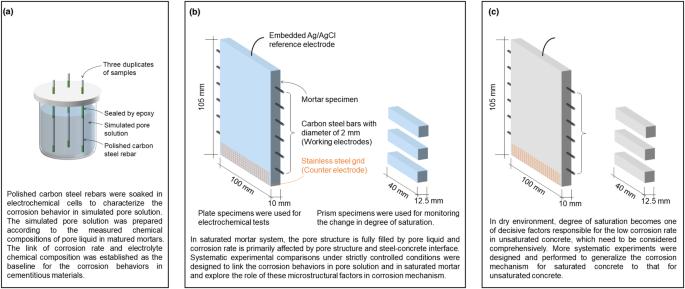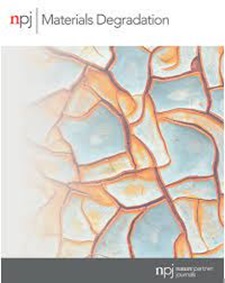Mechanisms and kinetic model for steel corrosion in unsaturated cementitious materials
IF 6.6
2区 材料科学
Q1 MATERIALS SCIENCE, MULTIDISCIPLINARY
引用次数: 0
Abstract
Considering the complex coupling of steel corrosion in partially saturated concrete filled with water, the quantitative description of control mechanisms is still under debate. This work provides new experimental evidence supporting that diffusion control (relative diffusion coefficient) is the dominant mechanism in controlling corrosion rate by limiting the ferrous ion migration in unsaturated concrete. Furthermore, a new mechanism-based kinetic model is developed to predict the corrosion rate in different cementitious materials and corrosion conditions. In addition, the proposed kinetic model can quantify the variation of critical [Cl−]/[OH−] with degree of saturation, classify corrosive conditions, and predict the electrical resistivity and corrosion rate relationships.

非饱和水泥基材料中的钢腐蚀机理和动力学模型
考虑到部分饱和充水混凝土中钢筋腐蚀的复杂耦合,对控制机制的定量描述仍存在争议。这项研究提供了新的实验证据,证明扩散控制(相对扩散系数)是通过限制非饱和混凝土中铁离子迁移来控制腐蚀速率的主要机制。此外,还建立了一个基于机理的新动力学模型,用于预测不同胶凝材料和腐蚀条件下的腐蚀速率。此外,所提出的动力学模型还能量化临界[Cl-]/[OH-]随饱和度的变化,对腐蚀条件进行分类,并预测电阻率与腐蚀速率的关系。
本文章由计算机程序翻译,如有差异,请以英文原文为准。
求助全文
约1分钟内获得全文
求助全文
来源期刊

npj Materials Degradation
MATERIALS SCIENCE, MULTIDISCIPLINARY-
CiteScore
7.80
自引率
7.80%
发文量
86
审稿时长
6 weeks
期刊介绍:
npj Materials Degradation considers basic and applied research that explores all aspects of the degradation of metallic and non-metallic materials. The journal broadly defines ‘materials degradation’ as a reduction in the ability of a material to perform its task in-service as a result of environmental exposure.
The journal covers a broad range of topics including but not limited to:
-Degradation of metals, glasses, minerals, polymers, ceramics, cements and composites in natural and engineered environments, as a result of various stimuli
-Computational and experimental studies of degradation mechanisms and kinetics
-Characterization of degradation by traditional and emerging techniques
-New approaches and technologies for enhancing resistance to degradation
-Inspection and monitoring techniques for materials in-service, such as sensing technologies
 求助内容:
求助内容: 应助结果提醒方式:
应助结果提醒方式:


